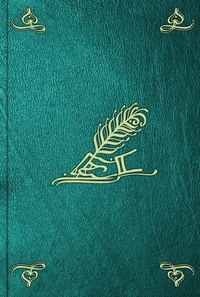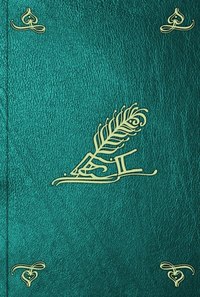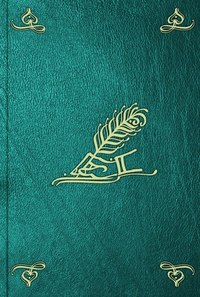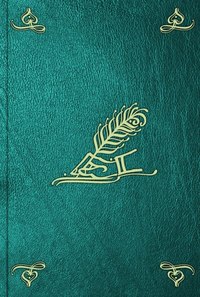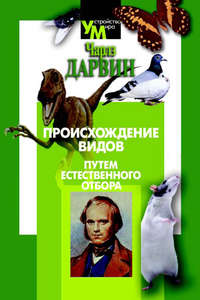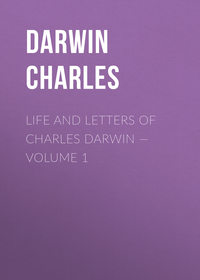 полная версия
полная версияПолная версия
The Expression of the Emotions in Man and Animals
Infants whilst young do not shed tears or weep, as is well known to nurses and medical men. This circumstance is not exclusively due to the lacrymal glands being as yet incapable of secreting tears. I first noticed this fact from having accidentally brushed with the cuff of my coat the open eye of one of my infants, when seventy-seven days old, causing this eye to water freely; and though the child screamed violently, the other eye remained dry, or was only slightly suffused with tears. A similar slight effusion occurred ten days previously in both eyes during a screaming-fit. The tears did not run over the eyelids and roll down the cheeks of this child, whilst screaming badly, when 122 days old. This first happened 17 days later, at the age of 139 days. A few other children have been observed for me, and the period of free weeping appears to be very variable. In one case, the eyes became slightly suffused at the age of only 20 days; in another, at 62 days. With two other children, the tears did NOT run down the face at the ages of 84 and 110 days; but in a third child they did run down at the age of 104 days. In one instance, as I was positively assured, tears ran down at the unusually early age of 42 days. It would appear as if the lacrymal glands required some practice in the individual before they are easily excited into action, in somewhat the same manner as various inherited consensual movements and tastes require some exercise before they are fixed and perfected. This is all the more likely with a habit like weeping, which must have been acquired since the period when man branched off from the common progenitor of the genus Homo and of the non-weeping anthropomorphous apes.
The fact of tears not being shed at a very early age from pain or any mental emotion is remarkable, as, later in life, no expression is more general or more strongly marked than weeping. When the habit has once been acquired by an infant, it expresses in the clearest manner suffering of all kinds, both bodily pain and mental distress, even though accompanied by other emotions, such as fear or rage. The character of the crying, however, changes at a very early age, as I noticed in my own infants, – the passionate cry differing from that of grief. A lady informs me that her child, nine months old, when in a passion screams loudly, but does not weep; tears, however, are shed when she is punished by her chair being turned with its back to the table. This difference may perhaps be attributed to weeping being restrained, as we shall immediately see, at a more advanced age, under most circumstances excepting grief; and to the influence of such restraint being transmitted to an earlier period of life, than that at which it was first practised.
With adults, especially of the male sex, weeping soon ceases to be caused by, or to express, bodily pain. This may be accounted for by its being thought weak and unmanly by men, both of civilized and barbarous races, to exhibit bodily pain by any outward sign. With this exception, savages weep copiously from very slight causes, of which fact Sir J. Lubbock[608] has collected instances. A New Zealand chief "cried like a child because the sailors spoilt his favourite cloak by powdering it with flour." I saw in Tierra del Fuego a native who had lately lost a brother, and who alternately cried with hysterical violence, and laughed heartily at anything which amused him. With the civilized nations of Europe there is also much difference in the frequency of weeping. Englishmen rarely cry, except under the pressure of the acutest grief; whereas in some parts of the Continent the men shed tears much more readily and freely.
The insane notoriously give way to all their emotions with little or no restraint; and I am informed by Dr. J. Crichton Browne, that nothing is more characteristic of simple melancholia, even in the male sex, than a tendency to weep on the slightest occasions, or from no cause. They also weep disproportionately on the occurrence of any real cause of grief. The length of time during which some patients weep is astonishing, as well as the amount of tears which they shed. One melancholic girl wept for a whole day, and afterwards confessed to Dr. Browne, that it was because she remembered that she had once shaved off her eyebrows to promote their growth. Many patients in the asylum sit for a long time rocking themselves backwards and forwards; "and if spoken to, they stop their movements, purse up their eyes, depress the corners of the mouth, and burst out crying." In some of these cases, the being spoken to or kindly greeted appears to suggest some fanciful and sorrowful notion; but in other cases an effort of any kind excites weeping, independently of any sorrowful idea. Patients suffering from acute mania likewise have paroxysms of violent crying or blubbering, in the midst of their incoherent ravings. We must not, however, lay too much stress on the copious shedding of tears by the insane, as being due to the lack of all restraint; for certain brain-diseases, as hemiplegia, brain-wasting, and senile decay, have a special tendency to induce weeping. Weeping is common in the insane, even after a complete state of fatuity has been reached and the power of speech lost. Persons born idiotic likewise weep;[609] but it is said that this is not the case with cretins.
Weeping seems to be the primary and natural expression, as we see in children, of suffering of any kind, whether bodily pain short of extreme agony, or mental distress. But the foregoing facts and common experience show us that a frequently repeated effort to restrain weeping, in association with certain states of the mind, does much in checking the habit. On the other hand, it appears that the power of weeping can be increased through habit; thus the Rev. R. Taylor,[610] who long resided in New Zealand, asserts that the women can voluntarily shed tears in abundance; they meet for this purpose to mourn for the dead, and they take pride in crying "in the most affecting manner."
A single effort of repression brought to bear on the lacrymal glands does little, and indeed seems often to lead to an opposite result. An old and experienced physician told me that he had always found that the only means to check the occasional bitter weeping of ladies who consulted him, and who themselves wished to desist, was earnestly to beg them not to try, and to assure them that nothing would relieve them so much as prolonged and copious crying.
The screaming of infants consists of prolonged expirations, with short and rapid, almost spasmodic inspirations, followed at a somewhat more advanced age by sobbing. According to Gratiolet,[611] the glottis is chiefly affected during the act of sobbing. This sound is heard "at the moment when the inspiration conquers the resistance of the glottis, and the air rushes into the chest." But the whole act of respiration is likewise spasmodic and violent. The shoulders are at the same time generally raised, as by this movement respiration is rendered easier. With one of my infants, when seventy-seven days old, the inspirations were so rapid and strong that they approached in character to sobbing; when 138 days old I first noticed distinct sobbing, which subsequently followed every bad crying-fit. The respiratory movements are partly voluntary and partly involuntary, and I apprehend that sobbing is at least in part due to children having some power to command after early infancy their vocal organs and to stop their screams, but from having less power over their respiratory muscles, these continue for a time to act in an involuntary or spasmodic manner, after having been brought into violent action. Sobbing seems to be peculiar to the human species; for the keepers in the Zoological Gardens assure me that they have never heard a sob from any kind of monkey; though monkeys often scream loudly whilst being chased and caught, and then pant for a long time. We thus see that there is a close analogy between sobbing and the free shedding of tears; for with children, sobbing does not commence during early infancy, but afterwards comes on rather suddenly and then follows every bad crying-fit, until the habit is checked with advancing years.
On the cause of the contraction of the muscles round the eyes during screaming. – We have seen that infants and young children, whilst screaming, invariably close their eyes firmly, by the contraction of the surrounding muscles, so that the skin becomes wrinkled all around. With older children, and even with adults, whenever there is violent and unrestrained crying, a tendency to the contraction of these same muscles may be observed; though this is often checked in order not to interfere with vision.
Sir C. Bell explains[612] this action in the following manner: – "During every violent act of expiration, whether in hearty laughter, weeping, coughing, or sneezing, the eyeball is firmly compressed by the fibres of the orbicularis; and this is a provision for supporting and defending the vascular system of the interior of the eye from a retrograde impulse communicated to the blood in the veins at that time. When we contract the chest and expel the air, there is a retardation of the blood in the veins of the neck and head; and in the more powerful acts of expulsion, the blood not only distends the vessels, but is even regurgitated into the minute branches. Were the eye not properly compressed at that time, and a resistance given to the shock, irreparable injury might be inflicted on the delicate textures of the interior of the eye." He further adds, "If we separate the eyelids of a child to examine the eye, while it cries and struggles with passion, by taking off the natural support to the vascular system of the eye, and means of guarding it against the rush of blood then occurring, the conjunctiva becomes suddenly filled with blood, and the eyelids everted."
Not only are the muscles round the eyes strongly contracted, as Sir C. Bell states and as I have often observed, during screaming, loud laughter, coughing, and sneezing, but during several other analogous actions. A man contracts these muscles when he violently blows his nose. I asked one of my boys to shout as loudly as he possibly could, and as soon as he began, he firmly contracted his orbicular muscles; I observed this repeatedly, and on asking him why he had every time so firmly closed his eyes, I found that he was quite unaware of the fact: he had acted instinctively or unconsciously.
It is not necessary, in order to lead to the contraction of these muscles, that air should actually be expelled from the chest; it suffices that the muscles of the chest and abdomen should contract with great force, whilst by the closure of the glottis no air escapes. In violent vomiting or retching the diaphragm is made to descend by the chest being filled with air; it is then held in this position by the closure of the glottis, "as well as by the contraction of its own fibres."[613] The abdominal muscles now contract strongly upon the stomach, its proper muscles likewise contracting, and the contents are thus ejected. During each effort of vomiting "the head becomes greatly congested, so that the features are red and swollen, and the large veins of the face and temples visibly dilated." At the same time, as I know from observation, the muscles round the eyes are strongly contracted. This is likewise the case when the abdominal muscles act downwards with unusual force in expelling the contents of the intestinal canal.
The greatest exertion of the muscles of the body, if those of the chest are not brought into strong action in expelling or compressing the air within the lungs, does not lead to the contraction of the muscles round the eyes. I have observed my sons using great force in gymnastic exercises, as in repeatedly raising their suspended bodies by their arms alone, and in lifting heavy weights from the ground, but there was hardly any trace of contraction in the muscles round the eyes.
As the contraction of these muscles for the protection of the eyes during violent expiration is indirectly, as we shall hereafter see, a fundamental element in several of our most important expressions, I was extremely anxious to ascertain how far Sir C. Bell's view could be substantiated. Professor Donders, of Utrecht,[614] well known as one of the highest authorities in Europe on vision and on the structure of the eye, has most kindly undertaken for me this investigation with the aid of the many ingenious mechanisms of modern science, and has published the results.[615] He shows that during violent expiration the external, the intra-ocular, and the retro-ocular vessels of the eye are all affected in two ways, namely by the increased pressure of the blood in the arteries, and by the return of the blood in the veins being impeded. It is, therefore, certain that both the arteries and the veins of the eye are more or less distended during violent expiration. The evidence in detail may be found in Professor Donders' valuable memoir. We see the effects on the veins of the head, in their prominence, and in the purple colour of the face of a man who coughs violently from being half choked. I may mention, on the same authority, that the whole eye certainly advances a little during each violent expiration. This is due to the dilatation of the retro-ocular vessels, and might have been expected from the intimate connection of the eye and brain; the brain being known to rise and fall with each respiration, when a portion of the skull has been removed; and as may be seen along the unclosed sutures of infants' heads. This also, I presume, is the reason that the eyes of a strangled man appear as if they were starting from their sockets.
With respect to the protection of the eye during violent expiratory efforts by the pressure of the eyelids, Professor Donders concludes from his various observations that this action certainly limits or entirely removes the dilatation of the vessels.[616] At such times, he adds, we not unfrequently see the hand involuntarily laid upon the eyelids, as if the better to support and defend the eyeball.
Nevertheless much evidence cannot at present be advanced to prove that the eye actually suffers injury from the want of support during violent expiration; but there is some. It is "a fact that forcible expiratory efforts in violent coughing or vomiting, and especially in sneezing, sometimes give rise to ruptures of the little (external) vessels" of the eye.[617] With respect to the internal vessels, Dr. Gunning has lately recorded a case of exophthalmos in consequence of whooping-cough, which in his opinion depended on the rupture of the deeper vessels; and another analogous case has been recorded. But a mere sense of discomfort would probably suffice to lead to the associated habit of protecting the eyeball by the contraction of the surrounding muscles. Even the expectation or chance of injury would probably be sufficient, in the same manner as an object moving too near the eye induces involuntary winking of the eyelids. We may, therefore, safely conclude from Sir C. Bell's observations, and more especially from the more careful investigations by Professor Donders, that the firm closure of the eyelids during the screaming of children is an action full of meaning and of real service.
We have already seen that the contraction of the orbicular muscles leads to the drawing up of the upper lip, and consequently, if the mouth is kept widely open, to the drawing down of the corners by the contraction of the depressor muscles. The formation of the naso-labial fold on the cheeks likewise follows from the drawing up of the upper lip. Thus all the chief expressive movements of the face during crying apparently result from the contraction of the muscles round the eyes. We shall also find that the shedding of tears depends on, or at least stands in some connection with, the contraction of these same muscles.
In some of the foregoing cases, especially in those of sneezing and coughing, it is possible that the contraction of the orbicular muscles may serve in addition to protect the eyes from too severe a jar or vibration. I think so, because dogs and cats, in crunching hard bones, always close their eyelids, and at least sometimes in sneezing; though dogs do not do so whilst barking loudly. Mr. Sutton carefully observed for me a young orang and chimpanzee, and he found that both always closed their eyes in sneezing and coughing, but not whilst screaming violently. I gave a small pinch of snuff to a monkey of the American division, namely, a Cebus, and it closed its eyelids whilst sneezing; but not on a subsequent occasion whilst uttering loud cries.
Cause of the secretion of tears. – It is an important fact which must be considered in any theory of the secretion of tears from the mind being affected, that whenever the muscles round the eyes are strongly and involuntarily contracted in order to compress the blood-vessels and thus to protect the eyes, tears are secreted, often in sufficient abundance to roll down the cheeks. This occurs under the most opposite emotions, and under no emotion at all. The sole exception, and this is only a partial one, to the existence of a relation between the involuntary and strong contraction of these muscles and the secretion of tears is that of young infants, who, whilst screaming violently with their eyelids firmly closed, do not commonly weep until they have attained the age of from two to three or four months. Their eyes, however, become suffused with tears at a much earlier age. It would appear, as already remarked, that the lacrymal glands do not, from the want of practice or some other cause, come to full functional activity at a very early period of life. With children at a somewhat later age, crying out or wailing from any distress is so regularly accompanied by the shedding of tears, that weeping and crying are synonymous terms.[618]
Under the opposite emotion of great joy or amusement, as long as laughter is moderate there is hardly any contraction of the muscles round the eyes, so that there is no frowning; but when peals of loud laughter are uttered, with rapid and violent spasmodic expirations, tears stream down the face. I have more than once noticed the face of a person, after a paroxysm of violent laughter, and I could see that the orbicular muscles and those running to the upper lip were still partially contracted, which together with the tear-stained cheeks gave to the upper half of the face an expression not to be distinguished from that of a child still blubbering from grief. The fact of tears streaming down the face during violent laughter is common to all the races of mankind, as we shall see in a future chapter.
In violent coughing especially when a person is half-choked, the face becomes purple, the veins distended, the orbicular muscles strongly contracted, and tears run down the cheeks. Even after a fit of ordinary coughing, almost every one has to wipe his eyes. In violent vomiting or retching, as I have myself experienced and seen in others, the orbicular muscles are strongly contracted, and tears sometimes flow freely down the cheeks. It has been suggested to me that this may be due to irritating matter being injected into the nostrils, and causing by reflex action the secretion of tears. Accordingly I asked one of my informants, a surgeon, to attend to the effects of retching when nothing was thrown up from the stomach; and, by an odd coincidence, he himself suffered the next morning from an attack of retching, and three days subsequently observed a lady under a similar attack; and he is certain that in neither case an atom of matter was ejected from the stomach; yet the orbicular muscles were strongly contracted, and tears freely secreted. I can also speak positively to the energetic contraction of these same muscles round the eyes, and to the coincident free secretion of tears, when the abdominal muscles act with unusual force in a downward direction on the intestinal canal.
Yawning commences with a deep inspiration, followed by a long and forcible expiration; and at the same time almost all the muscles of the body are strongly contracted, including those round the eyes. During this act tears are often secreted, and I have seen them even rolling down the cheeks.
I have frequently observed that when persons scratch some point which itches intolerably, they forcibly close their eyelids; but they do not, as I believe, first draw a deep breath and then expel it with force; and I have never noticed that the eyes then become filled with tears; but I am not prepared to assert that this does not occur. The forcible closure of the eyelids is, perhaps, merely a part of that general action by which almost all the muscles of the body are at the same time rendered rigid. It is quite different from the gentle closure of the eyes which often accompanies, as Gratiolet remarks,[619] the smelling a delicious odour, or the tasting a delicious morsel, and which probably originates in the desire to shut out any disturbing impression through the eyes.
Professor Donders writes to me to the following effect: "I have observed some cases of a very curious affection when, after a slight rub (attouchement), for example, from the friction of a coat, which caused neither a wound nor a contusion, spasms of the orbicular muscles occurred, with a very profuse flow of tears, lasting about one hour. Subsequently, sometimes after an interval of several weeks, violent spasms of the same muscles re-occurred, accompanied by the secretion of tears, together with primary or secondary redness of the eye." Mr. Bowman informs me that he has occasionally observed closely analogous cases, and that, in some of these, there was no redness or inflammation of the eyes.
I was anxious to ascertain whether there existed in any of the lower animals a similar relation between the contraction of the orbicular muscles during violent expiration and the secretion of tears; but there are very few animals which contract these muscles in a prolonged manner, or which shed tears. The Macacus maurus, which formerly wept so copiously in the Zoological Gardens, would have been a fine case for observation; but the two monkeys now there, and which are believed to belong to the same species, do not weep. Nevertheless they were carefully observed by Mr. Bartlett and myself, whilst screaming loudly, and they seemed to contract these muscles; but they moved about their cages so rapidly, that it was difficult to observe with certainty. No other monkey, as far as I have been able to ascertain, contracts its orbicular muscles whilst screaming.
The Indian elephant is known sometimes to weep. Sir E. Tennent, in describing these which he saw captured and bound in Ceylon, says, some "lay motionless on the ground, with no other indication of suffering than the tears which suffused their eyes and flowed incessantly." Speaking of another elephant he says, "When overpowered and made fast, his grief was most affecting; his violence sank to utter prostration, and he lay on the ground, uttering choking cries, with tears trickling down his cheeks."[620] In the Zoological Gardens the keeper of the Indian elephants positively asserts that he has several times seen tears rolling down the face of the old female, when distressed by the removal of the young one. Hence I was extremely anxious to ascertain, as an extension of the relation between the contraction of the orbicular muscles and the shedding of tears in man, whether elephants when screaming or trumpeting loudly contract these muscles. At Mr. Bartlett's desire the keeper ordered the old and the young elephant to trumpet; and we repeatedly saw in both animals that, just as the trumpeting began, the orbicular muscles, especially the lower ones, were distinctly contracted. On a subsequent occasion the keeper made the old elephant trumpet much more loudly, and invariably both the upper and lower orbicular muscles were strongly contracted, and now in an equal degree. It is a singular fact that the African elephant, which, however, is so different from the Indian species that it is placed by some naturalists in a distinct sub-genus, when made on two occasions to trumpet loudly, exhibited no trace of the contraction of the orbicular muscles.
From the several foregoing cases with respect to Man, there can, I think, be no doubt that the contraction of the muscles round the eyes, during violent expiration or when the expanded chest is forcibly compressed, is, in some manner, intimately connected with the secretion of tears. This holds good under widely different emotions, and independently of any emotion. It is not, of course, meant that tears cannot be secreted without the contraction of these muscles; for it is notorious that they are often freely shed with the eyelids not closed, and with the brows unwrinkled. The contraction must be both involuntary and prolonged, as during a choking fit, or energetic, as during a sneeze. The mere involuntary winking of the eyelids, though often repeated, does not bring tears into the eyes. Nor does the voluntary and prolonged contraction of the several surrounding muscles suffice. As the lacrymal glands of children are easily excited, I persuaded my own and several other children of different ages to contract these muscles repeatedly with their utmost force, and to continue doing so as long as they possibly could; but this produced hardly any effect. There was sometimes a little moisture in the eyes, but not more than apparently could be accounted for by the squeezing out of the already secreted tears within the glands.




